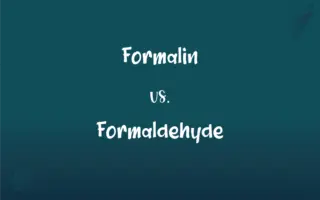Mitochondrial DNA vs. Chloroplast DNA: What's the Difference?
Edited by Aimie Carlson || By Janet White || Published on January 18, 2024
Mitochondrial DNA (mtDNA) is found in mitochondria, involved in energy production, while chloroplast DNA (cpDNA) is in chloroplasts, crucial for photosynthesis.

Key Differences
Mitochondrial DNA (mtDNA) is located in the mitochondria, the cell's powerhouse, and is involved in cellular respiration and energy production. Chloroplast DNA (cpDNA), found in chloroplasts, plays a key role in photosynthesis, the process by which plants convert light into energy.
In terms of inheritance, mtDNA is typically maternally inherited in most organisms, meaning it's passed down from the mother. Conversely, cpDNA is often inherited biparentally or maternally, depending on the species, indicating a different inheritance pattern.
The structure of mtDNA is usually circular and relatively small, containing genes crucial for mitochondrial function. Chloroplast DNA is also circular but has a larger genome than mtDNA, containing genes vital for photosynthesis and other chloroplast functions.
mtDNA mutations are known to be associated with various human diseases, due to its role in cellular energy production. In contrast, mutations in cpDNA can affect plant development and photosynthesis, impacting plant health and productivity.
In terms of evolutionary significance, mtDNA is used extensively in animal genetic studies and human ancestry research due to its high mutation rate and maternal inheritance. cpDNA is similarly valuable in studying plant evolution and phylogeny, given its unique gene content and inheritance patterns.
ADVERTISEMENT
Comparison Chart
Location in Cell
Mitochondria
Chloroplasts
Main Function
Cellular respiration, energy production
Photosynthesis
Inheritance Pattern
Mostly maternal
Biparental or maternal, species-dependent
Genome Size and Structure
Smaller, circular
Larger, circular
Evolutionary Use
Animal genetic studies, human ancestry
Plant evolution, phylogeny
ADVERTISEMENT
Mitochondrial DNA and Chloroplast DNA Definitions
Mitochondrial DNA
Typically inherited from the mother.
The maternal inheritance of mitochondrial DNA is useful for tracing lineage.
Chloroplast DNA
Larger genome than mitochondrial DNA.
The larger size of chloroplast DNA allows for more genetic information.
Mitochondrial DNA
Used in genetic and ancestry research.
Scientists study mitochondrial DNA to understand human evolutionary history.
Chloroplast DNA
Used in plant phylogeny studies.
Chloroplast DNA analysis helps in understanding plant evolutionary relationships.
Mitochondrial DNA
DNA located in mitochondria.
Mitochondrial DNA mutations can lead to energy production disorders.
Chloroplast DNA
Often inherited biparentally or maternally.
Chloroplast DNA inheritance can vary between plant species.
Mitochondrial DNA
Plays a role in cellular respiration.
Mitochondrial DNA encodes for proteins essential for energy metabolism.
Chloroplast DNA
DNA found in chloroplasts.
Chloroplast DNA is crucial for the photosynthesis process in plants.
Mitochondrial DNA
Contains genes for mitochondrial function.
Disorders in mitochondrial DNA can disrupt normal cell function.
Chloroplast DNA
Involved in photosynthesis.
Genes in chloroplast DNA encode proteins for light absorption.
FAQs
Can mutations in mitochondrial DNA affect health?
Yes, they can lead to various diseases.
Where is chloroplast DNA found?
In chloroplasts, crucial for photosynthesis.
What is the role of chloroplast DNA?
It plays a key role in photosynthesis.
How is mitochondrial DNA inherited?
Typically through maternal lineage.
Is chloroplast DNA larger than mitochondrial DNA?
Yes, it generally has a larger genome.
Are both types of DNA circular?
Yes, both are typically circular.
How is chloroplast DNA inherited?
It varies, often biparentally or maternally.
Does mitochondrial DNA mutation rate vary?
Yes, it varies among species.
What does mitochondrial DNA code for?
It codes for proteins crucial for mitochondrial function.
What species have chloroplast DNA?
Mainly plants and some algae.
How does chloroplast DNA affect plant health?
Mutations can impair photosynthesis and growth.
What is mitochondrial DNA?
DNA located in the mitochondria, involved in energy production.
Is chloroplast DNA used in evolutionary studies?
Yes, especially for plant evolution.
Can mitochondrial DNA be used for ancestry research?
Yes, particularly for maternal lineage.
Are there non-genetic functions for mitochondrial DNA?
Mainly genetic, but research is ongoing.
Are there therapies targeting mitochondrial DNA disorders?
Research is ongoing, but some treatments exist.
How does the size of chloroplast DNA benefit plants?
It allows for more genetic information and functions.
Is mitochondrial DNA only found in humans?
No, it's found in most eukaryotes.
Can chloroplast DNA be engineered?
Yes, for research and biotechnology.
Do both types of DNA replicate independently?
Yes, they replicate independently of nuclear DNA.
About Author
Written by
Janet WhiteJanet White has been an esteemed writer and blogger for Difference Wiki. Holding a Master's degree in Science and Medical Journalism from the prestigious Boston University, she has consistently demonstrated her expertise and passion for her field. When she's not immersed in her work, Janet relishes her time exercising, delving into a good book, and cherishing moments with friends and family.
Edited by
Aimie CarlsonAimie Carlson, holding a master's degree in English literature, is a fervent English language enthusiast. She lends her writing talents to Difference Wiki, a prominent website that specializes in comparisons, offering readers insightful analyses that both captivate and inform.





































































